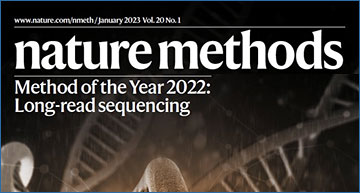Long-read sequencing powers a more complete reading of genomic information.
Long-read sequencing is enabling in reading genomes, transcriptomes and epigenomes in humans and other species. For its momentous methodological advancement and broad application, Nature Methods has chosen long-read sequencing as their Method of the Year 2022.
Since the advent of next-generation sequencing nearly two decades ago, the pace of technological innovation has never slowed. Although powerful algorithms strive to connect short reads relying on overlapping sequences, the sheer length and complexity of many genomes pose severe hurdles in generating complete sequences, often resulting in many missing parts and errors. This motivated the development of various strategies for long-read sequencing. The two most widely used commercial technologies are Pacific Biosciences’ Single Molecule Real-Time (SMRT) sequencing (average read length ~20 kb with >99.9% accuracy for HiFi reads) and Oxford Nanopore Technologies’ nanopore sequencing (average read length ~100 kb for ultra-long reads, ~99% accuracy for R10.4). Their distinct sequencing principles and approaches to data generation yield sequencing reads with varied lengths, error rates and throughputs. Researchers may find one long-read sequencing technology better to meet their research goals and resource requirements, depending on the application, and both techniques are continually evolving. In a Technology Feature in this issue, Vivien Marx highlights voices from several researchers developing and applying long-read sequencing in various areas, including interesting stories from its early days and perspectives on the future.
Method of the Year 2022: long-read sequencing. Nat Methods 20(1):1. [editorial]





